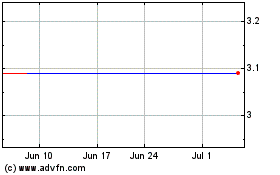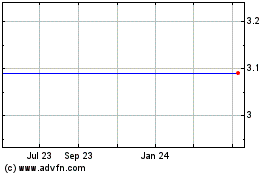Bank of England to Ease Capital Pressure on U.K. Banks -- 4th Update
December 01 2015 - 9:49AM
Dow Jones News
By Max Colchester, Jason Douglas and Margot Patrick
LONDON--The Bank of England Tuesday declared an end to years of
financial-crisis banking reforms, saying U.K. banks had broadly
done enough to strengthen their balance sheets.
The central bank said that capital requirements for its once
crippled banking sector wouldn't continue to creep up in coming
years. Instead, it set a capital target that most U.K. lenders have
nearly already hit.
"The system is in sight of where it needs to be," said Bank of
England Governor Mark Carney during a news conference. "There is no
new wave of capital regulation coming."
The softer tone from the Bank of England comes as it feels more
confident it can safely wind-down broken banks and avoid tapping
taxpayers for bailouts. Following the financial crisis, U.K.
regulators moved to shore up the country's battered banking system
with a wave of measures. A key question was how much equity and
bonds banks needed to hold to absorb potential losses.
On Tuesday, Mr. Carney said British banks needed to hold Tier 1
equity of 11% of risk-adjusted assets by 2019. This is slightly
above the international average, he said, but remains well below
the amount some regulators predicted banks would need to hold in
the wake of the crisis.
British banks have recently undertaken a broad lobbying campaign
to push regulators to loosen their rules, or risk damaging the
U.K.'s attractiveness as a financial center. Mr. Carney hit back at
complaints that the stream of new regulations was unpredictable and
hindering banks' ability to pump credit into the economy. "Our
objective has never been to raise capital without limit," he
said.
Mr. Carney's pledge was welcomed by markets as British bank
stocks rose. Barclays PLC led the pack with shares up nearly 5% in
early-afternoon trading.
The Bank of England can still tweak capital rules depending on
the strength of the economy. Officials signaled they will consider
raising a special capital buffer in March. A 1% increase would be
equivalent to GBP10 billion ($15 billion) of extra capital. But the
central bank said some of that would come from reallocating capital
already held by banks.
The announcement came as the Bank of England issued the results
of its latest U.K. bank stress test. The Royal Bank of Scotland
Group PLC and Standard Chartered PLC both failed aspects of the
balance-sheet check but the central bank stopped short of forcing
them to raise more capital.
The stress test saw a hypothetical scenario where the eurozone
and Chinese economies contract, commodity prices crash and banks
wrestle with the default of a handful of major trading partners.
Meanwhile, fines for bad behavior shot up. Two of the seven banks
tested, RBS and Standard Chartered, were singled out for weaknesses
by the Bank of England but have already taken action to strengthen
their balance sheets, the central bank said Tuesday.
Seven British based banks needed to maintain a ratio of core
Tier 1 equity to risk weighted assets of 4.5% to pass the test but
were also assessed individually. Banks that fell short would have
needed to raise equity or further shrink their balance sheets. The
banks tested were RBS, Barclays, HSBC Holdings PLC, Lloyds Banking
Group PLC, Nationwide Building Society, Santander U.K. and Standard
Chartered.
RBS didn't meet an individualized capital requirement set by the
regulator.
The central bank said that the state-controlled lender had
already planned to issue bonds which would address any shortfall.
Asia-focused Standard Chartered didn't hit a key measure but still
passed the test, the Bank of England said. The bank has already
outlined plans to raise $5.1 billion in equity and restructure its
business.
The results of the stress test were published alongside the Bank
of England's twice-yearly assessment of the risks facing the
financial system. Officials cited potential threats from certain
corners of the real-estate market and financial-market fragility,
but concluded the risks weren't strong enough to warrant any new
policy actions.
Write to Max Colchester at max.colchester@wsj.com, Jason Douglas
at jason.douglas@wsj.com and Margot Patrick at
margot.patrick@wsj.com
(END) Dow Jones Newswires
December 01, 2015 09:34 ET (14:34 GMT)
Copyright (c) 2015 Dow Jones & Company, Inc.
Royal Bank of Scotland (NYSE:RBS)
Historical Stock Chart
From Mar 2024 to Apr 2024

Royal Bank of Scotland (NYSE:RBS)
Historical Stock Chart
From Apr 2023 to Apr 2024
